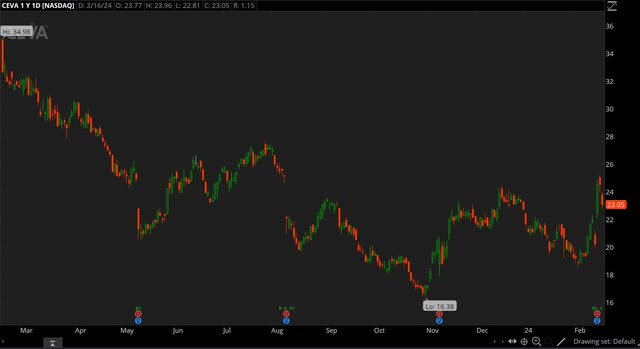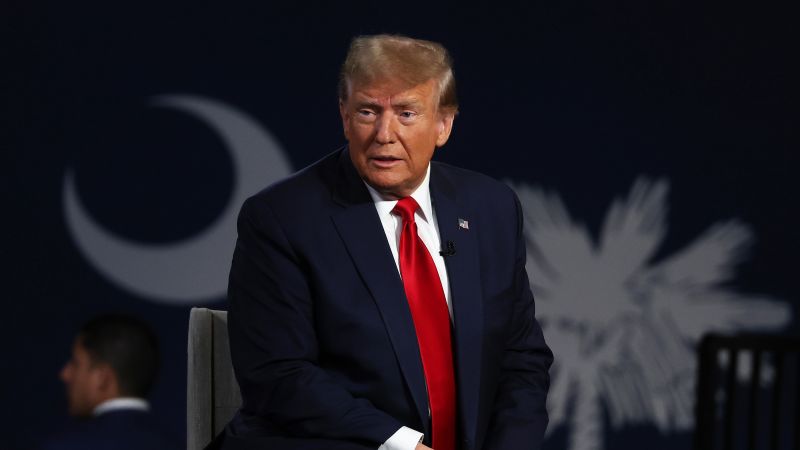CEVA, Inc. (NASDAQ:CEVA), a licensor of IP for wireless connectivity technologies, smart sensing, and other solutions, released its Q4 report on February 14, and it could not have come soon enough. The stock rallied in the last couple of months of 2023 after hitting a multi-year low in late October, but the stock headed down as soon as 2024 got off to a start. However, the latest report from CEVA was able to reverse the tide. The market appears to have approved the latest report from CEVA, just as it did the most recent Investor Presentation from CEVA. Why will be covered next?
Why the Q4 report had to come to the rescue
A previous article from mid-November rated CEVA a hold, even though the stock had soared higher after a major decline that culminated with a multi-year low of $16.39 on October 31. The article did so after concluding that CEVA was still facing a number of headwinds, which could cause the stock to drop once more, possibly as quickly as it had jumped higher.
Source: Thinkorswim app
The chart above shows how the stock was on track to do just that. The rally stalled after hitting a high of $24.47 on December 15 for an almost 50% increase compared to the October low, and the fade accelerated into 2024. The stock dropped to a low of $18.54 on February 2 before turning it around the rest of the way to a high of $25.19 on February 15. The February rally was needed to keep the stock from heading towards the October low.
This February rally would not have happened without the assistance of the Q4 report, given the spike following the Q4 report. The consensus expected CEVA to report non-GAAP EPS of $0.06, but CEVA earned $0.10 on revenue of $24.2M, which is five times what it earned in the preceding quarter. Note that CEVA bought back 144K shares in Q4, which boosted EPS gains. In terms of GAAP, CEVA posted a loss of $8.1M or $0.34 from continuing ops.
Keep in mind that CEVA has divested of Intrinsix and the numbers have been adjusted for this. Licensing and related revenue contributed $11.8M and royalty revenue contributed the remaining $12.3M. CEVA signed 17 licensing agreements, including 3 with new customers. The table below shows the numbers for Q4 FY2023 versus Q3 FY2023 and Q4 FY2022.
|
(Unit: $1000, except EPS) |
|||||
|
(GAAP) |
Q4 FY2023 |
Q3 FY2023 |
Q4 FY2022 |
QoQ |
YoY |
|
Revenue |
24,162 |
24,073 |
30,350 |
0.37% |
(20.39%) |
|
Gross margin |
91% |
90% |
89% |
100bps |
200bps |
|
Operating income (loss) |
(2,787) |
(2,717) |
1,009 |
– |
– |
|
Net income (loss) |
3,769 |
(4,957) |
1,940 |
– |
94.28% |
|
Net income (loss) from continuing ops |
(8,098) |
(2,750) |
4,519 |
– |
– |
|
EPS |
0.16 |
(0.21) |
0.08 |
– |
100.00% |
|
EPS (continuing ops) |
(0.34) |
(0.12) |
0.19 |
– |
– |
|
(Non-GAAP) |
|||||
|
Gross margin |
92% |
92% |
90% |
– |
200bps |
|
Operating income (loss) |
1,946 |
1,630 |
6,772 |
19.39% |
(71.26%) |
|
Net income (loss) |
2,378 |
414 |
5,602 |
474.40% |
(57.55%) |
|
EPS |
0.10 |
0.02 |
0.23 |
400.00% |
(56.52%) |
Source: CEVA
In FY2023, revenue declined by 19.2% YoY to $97.4M and non-GAAP EPS declined by 97.2% YoY to $0.10. Keep in mind FY2022 revenue was actually $134.6M, but it is $120.6M without discontinued operations. In terms of GAAP, CEVA posted a loss of $18.4M or $0.79 a share from continuing ops. CEVA finished FY2023 with cash, cash equivalents, marketable securities and short-term bank deposits of $166.5M on the balance sheet with no debt. The table below shows how the numbers got worse in FY2023 YoY.
|
(Unit: $1000, except EPS) |
|||
|
(GAAP) |
FY2023 |
FY2022 |
YoY |
|
Revenue |
97,419 |
120,583 |
(19.21%) |
|
Gross margin |
88% |
87% |
100bps |
|
Operating income (loss) |
(13,467) |
3,896 |
– |
|
Net income (loss) |
(11,878) |
(23,183) |
– |
|
Net income (loss) from continuing ops |
(18,437) |
(13,878) |
– |
|
EPS |
(0.51) |
(1.00) |
– |
|
EPS (continuing ops) |
(0.79) |
(0.60) |
– |
|
(Non-GAAP) |
|||
|
Gross margin |
89% |
90% |
(100bps) |
|
Operating income (loss) |
3,645 |
22,985 |
(84.14%) |
|
Net income (loss) |
2,419 |
18,835 |
(87.16%) |
|
EPS |
0.10 |
0.78 |
(87.18%) |
Source: CEVA
FY2023 was not a good year for CEVA, but shipment data points to demand getting better. Licensees shipped 1.6B units in FY2023, which is less than FY2022’s 1.7B. However, 453M units were shipped in Q4, which is up 21% YoY and a sign of improving demand. Bluetooth shipments held the largest share with 244M in Q4 and 957M for all of FY2023.
What to expect from CEVA in FY2024
Guidance calls for Q1 FY2024 revenue to decline by 2-6% QoQ, which implies revenue of $22.7-23.7M. Non-GAAP EPS is harder to estimate for several reasons, including changes in product mix and the impact of stock buybacks by CEVA, but it is likely to fall in the $0.03-0.05 range. From the Q4 earnings call:
Specifically for the first quarter of 2024, with typical seasonality in shipments of consumer IoT and mobile products, post the holiday season, we expect overall revenue to be 2% to 6% lower sequentially, and with a different mix of licensing and royalty revenues than from the quarter we just reported.”
Source: CEVA earnings call
On the other hand, growth is expected to pick up in FY2024. The second half is expected to feature stronger growth than the first half, resulting in FY2024 revenue increasing by 4-8% YoY.
So, overall, we’re talking about 4% to 8% annual revenue growth for 2024. We’re looking at similar start than we had in 2023 that the first half may be a bit more milder and then things will pick up.
Some of the products we are in and the consumer side also have that typical seasonality, and we have seen that in the past.”
This implies FY2024 revenue of $101.3-105.2M. Non-GAAP EPS is estimated to end up at around $0.28-0.32, although there are several factors that could sway the final number, including stock buybacks. Remember that CEVA increased the size of the share buyback program in November.
The stock price closed at $23.05 on February 16, and assuming non-GAAP EPS of $0.30, which would give CEVA a non-GAAP forward P/E multiple of 76.8x. This number looks high, but it is much lower than the trailing P/E, which stands at 230.5x with non-GAAP EPS of $0.10 and a stock price of $23.05. In a nutshell, FY2024 should be better than FY2023.
CEVA updates its long-term financial model
CEVA had nothing more to add to the outlook, but CEVA had previously released an updated long-term financial model in December, an Investor Presentation which can be downloaded from CEVA’s website. The model, using FY2023 as the baseline, sees revenue growing at a CAGR of 8-12% over the next four years. If we take the midpoint or a CAGR of 10% and FY2023 revenue of $97.4M, then this would result in FY2027 revenue of $142.6M.
The model sees gross margin of 90% or more, leading to non-GAAP EPS of $1.00 or more. This suggests a stock price of $81.90, assuming CEVA hits the target of non-GAAP EPS of $1.00 by FY2027 and assuming a P/E multiple of 81.9x, the average for the last five years. This is fairly close to the February 2021 all-time high of $83.95, before the stock proceeded to go on a long decline that ended with the October 2023 low of $16.38.
How much of a headwind could China be for CEVA?
The above looks enticing with the stock at $23.05, well below where it could trade in the next several years, assuming CEVA hits its targets. However, there are potential hurdles CEVA will have to overcome if it is to grow earnings like it wants to in the next four years. As mentioned before, CEVA is dealing with headwinds, which have arguably been more severe than previously anticipated.
For instance, the 5G base station market was weaker than expected for CEVA, part of the reason why royalties from 5G-RAN were down 22% in FY2023. It’s not the only reason, but a major factor is because Huawei, the leading supplier of 5G base stations, has won more contracts than once expected after the U.S. imposed sanctions on Huawei. This affects CEVA because Huawei does not use IP from CEVA, unlike other base station suppliers.
The same, Huawei is increasingly developing its own IP that competes directly against those from traditional suppliers like CEVA. For example, Huawei and other Chinese companies came up with an alternative for Bluetooth, which could on paper serve as a replacement, something that would go against CEVA due to its heavy exposure to the Bluetooth market and the Wi-Fi market to a lesser extent.
Keep in mind, customers in China accounted for 56% of FY2022 revenue, according to CEVA’s annual report. It’s possible share loss in China could offset, in part or even in full, growth elsewhere in the world. So while CEVA may be optimistic about its growth prospects as shown by the recent 2023 Investor Presentation, it is possible growth could end up being far less.
Investor takeaways
It’s been up and down lately for CEVA, but it is fair to say the stock has done much better in the last several months. The stock declined for almost three years, with the low coming as recently as late October, but CEVA has since gained over 40% in value. Several factors have contributed to making this possible.
Demand seems to be getting better if shipment data is any indication. The latest quarterly report shows significant improvement, especially in terms of earnings. The outlook for FY2024 calls for a much better year than FY2023, with growth set to return. Guidance calls for Q1 FY024 to decline by 2-6% QoQ, but by the end of the year, FY2024 revenue is expected to be up 4-8% YoY.
CEVA is upbeat about its prospects, especially with semiconductor demand expected to grow in the coming years. This mindset is reflected in the latest financial model from CEVA, which targets a CAGR of 8-12% in FY2023-2027. Non-GAAP EPS is expected to hit $1.00 by the end of the period, which represents strong earnings growth in the next four years.
If CEVA achieves its goals, CEVA will have accomplished a huge turnaround from what looked to be a rather bleak situation just a few months ago. However, there is reason to question whether CEVA will hit its targets as set forth by the company. And if CEVA experiences headwinds more than expected, it is likely to be in China, a major market for CEVA.
China used the last couple of years to install millions of 5G base stations, but CEVA saw little benefit because most of it was sourced from Huawei. The 5G rollout is just one example of how CEVA may not necessarily benefit as much as expected from the rising use of semiconductors worldwide. The semiconductor market is becoming more fragmented with countries like China increasingly determined to develop their own IP instead of licensing it from an outside actor, such as CEVA, like in the past.
A more fragmented world is a headwind for a supplier of IPs like CEVA because it effectively shrinks the size of the market. Instead of licensing IP to the entire world, only certain parts can be accessed as others are locked out for a number of reasons, including government-imposed trade restrictions. This does not mean CEVA cannot grow in such a world, just that its potential growth is less in such a world.
I am neutral on CEVA since it is too early to say that CEVA has put its struggles behind it. Yes, the stock has done much better and it is still way off the peak from a few years, but CEVA can be argued to be an expensive stock in light of its recent growth, or more precisely the lack of it, and its current valuations, which include multiples in the triple digits for certain metrics.
If CEVA is to justify its current valuation, it needs to live up to the expected growth of the next few years. This is not a sure thing, especially if one assumes the recent trend of a country like China turning increasingly towards its own IP is a sign of things to come. CEVA has done better in recent months, but whether the recent rally continues or peters off remains to be seen.
Read the full article here







